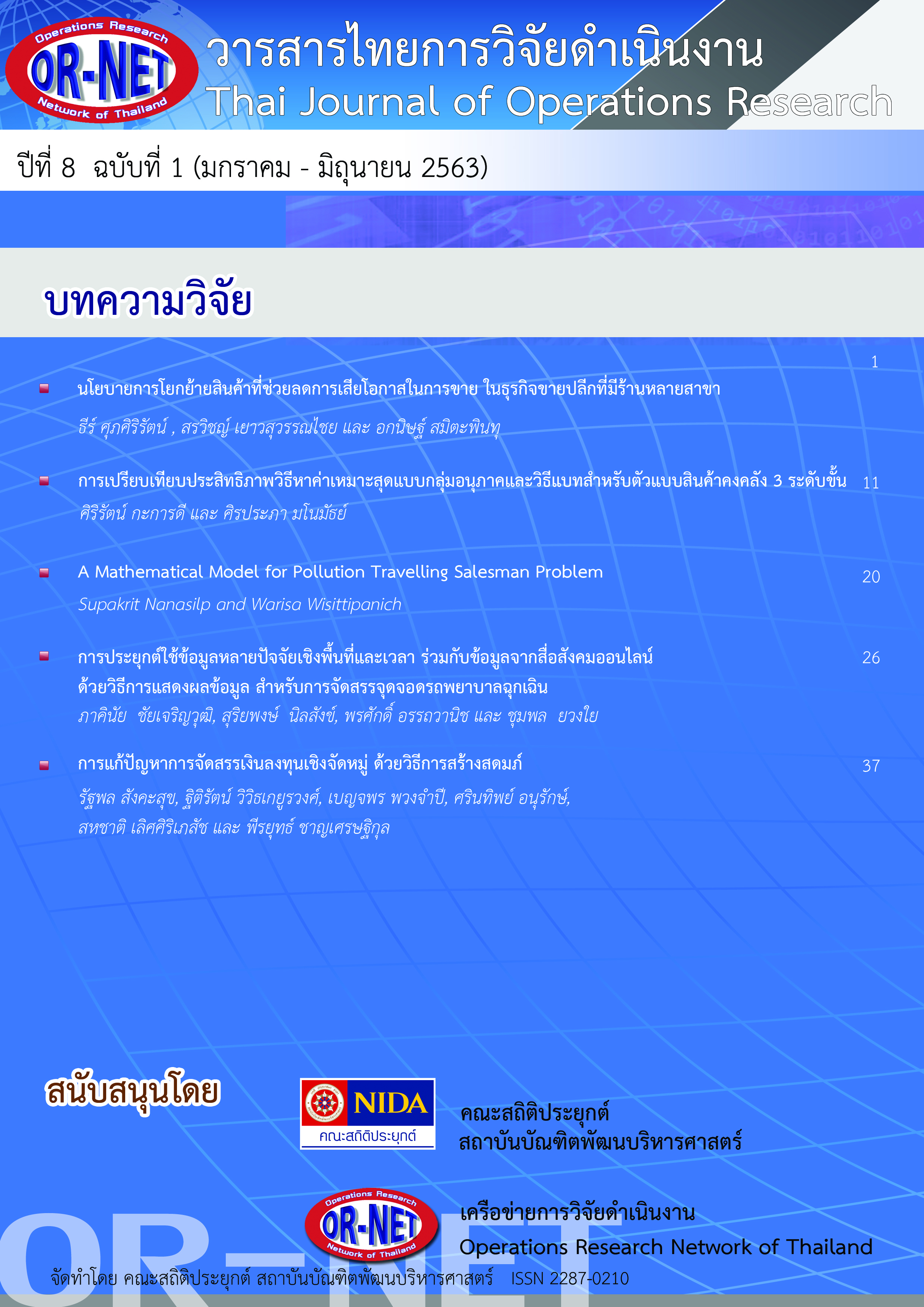Capital Budgeting Problem with Combinatorial Allocation Constraints by Column Generation Method
Keywords:
Capital Budgeting Problem, Combinatorial Allocation, Column-generation, OptimizationAbstract
This research studied the method to solve the problem of capital allocation in order to reach the optimal profit by Column Generation technique with 3 methodologies; Full model of Linear programming, Row Generation and Column Generation. The study compare between performance and number of projects to do operate in qualities and time. The result showed that the small size of problem solution by Column Generation gave the same answer to the solution by full model of linear programming and Row Generation. The method of Column Generation is supported the solutions that are larger than by Full model of linear programming Row Generation. Due as Column Generation is a method that using variable increment in each column decision. In the other hand, the solution by Full model of linear programming considers to solve every possibility and Row Generation is a method that using constraints increment. Therefore, the processing program which creating Row Generation use more processing resources and resulting in a shorter processing time in the method of Column Generation.
References
[2] DóraBalog, Tamás László Bátyi, Péter Csóka and Miklós Pintér. Properties and comparison of risk capital allocation methods. European Journal of Operational Research. Vol. 259. pp. 614-625. 2017.
[3] Jiming Wang, Aiqun Wang. Data envelope analysis on capital allocation efficiency using hybrid fuzzy method. Computers & Electrical Engineering. Vol. 71. Pages 206-211. ISSN 0045-7906.https://doi.org/10.1016/j.compeleceng.2018.07.050. 2018.
[4] Wolfgang Drobetz Malte Janzen and Ignacio Requejo. Capital allocation and ownership concentration in the shipping industry. Transportation Research Part E: Logistics and Transportation Review. Vol. 122. pp. 78-99. 2019.
[5] เอราวิล ถาวร เริงทิวา ทิพยศักดิ์ อภิศักดิ์ วิทยาประภากร และ พีรยุทธ์ ชาญเศรษฐิกุล. การแก้ปัญหาการจัดสรรเงินลงทุนเชิงจัดหมู่ด้วยเทคนิคการสร้างแถว วารสารไทยการวิจัยดำเนินงาน ปีที่ 6ฉบับที่ 2 (กรกฎาคม-ธันวาคม 2561). หน้า 10-21
[6] Gilmore, P.C. & Gomory, Ralph. A Linear Programming Approach to the Cutting Stock Problem—Part II. Operations Research. 11. 10.1287/opre.11.6.863. 1961.
[7] Goberna and Lopez. Linear Semi-Infinite Programming Theory: An Updated Survey. European Journal of Operational Research. Vol. 143. pp. 390-405. 2002.
[8] Charnes et al., On Representation of Semi-Infinite Programs Which Have No Duality Gaps. Management science. Vol. 12. pp. 113-121. 1965.
[9] Peerayuth Charnsethikul. A column generations approach for the products mix. Management science and engineering management. Vol. 6. pp. 105-108. 2002.
[10] Hopp, W., Spearman, M., Factory Physiscs 3rd (third) Edition. Waveland Pr Inc. (31 August 2011) 2011.
[11] Charnes, A., Cooper, W., and Kortanek, O. On Representation of Semi-Infinite Programs Which Have No Duality Gaps. Management Science. 12 (1). pp. 113–121. 1965.
[12] M. Gamache, F. Soumis, G. Marquis, and J. Desrosiers. A Column generation approach for large-scale aircrew rostering problems” Operations Research. Vol. 47. pp. 247-263. 1999.
[13] Arianna Alfieri, et.al. “The time buffer approximated Buffer Allocation Problem: A row–column generation approach”. Computers & Operations Research. Vol. 115. 2020.
[14] G. Dantzing R. Fulkerson, and S. Johnson. Solution of a large-scale travelling-salesman problem. Journal of the Operation Research Society of America. pp. 393-410. 1954.




